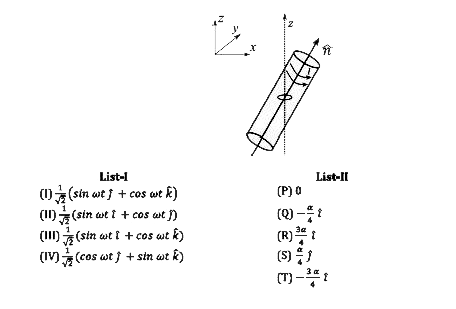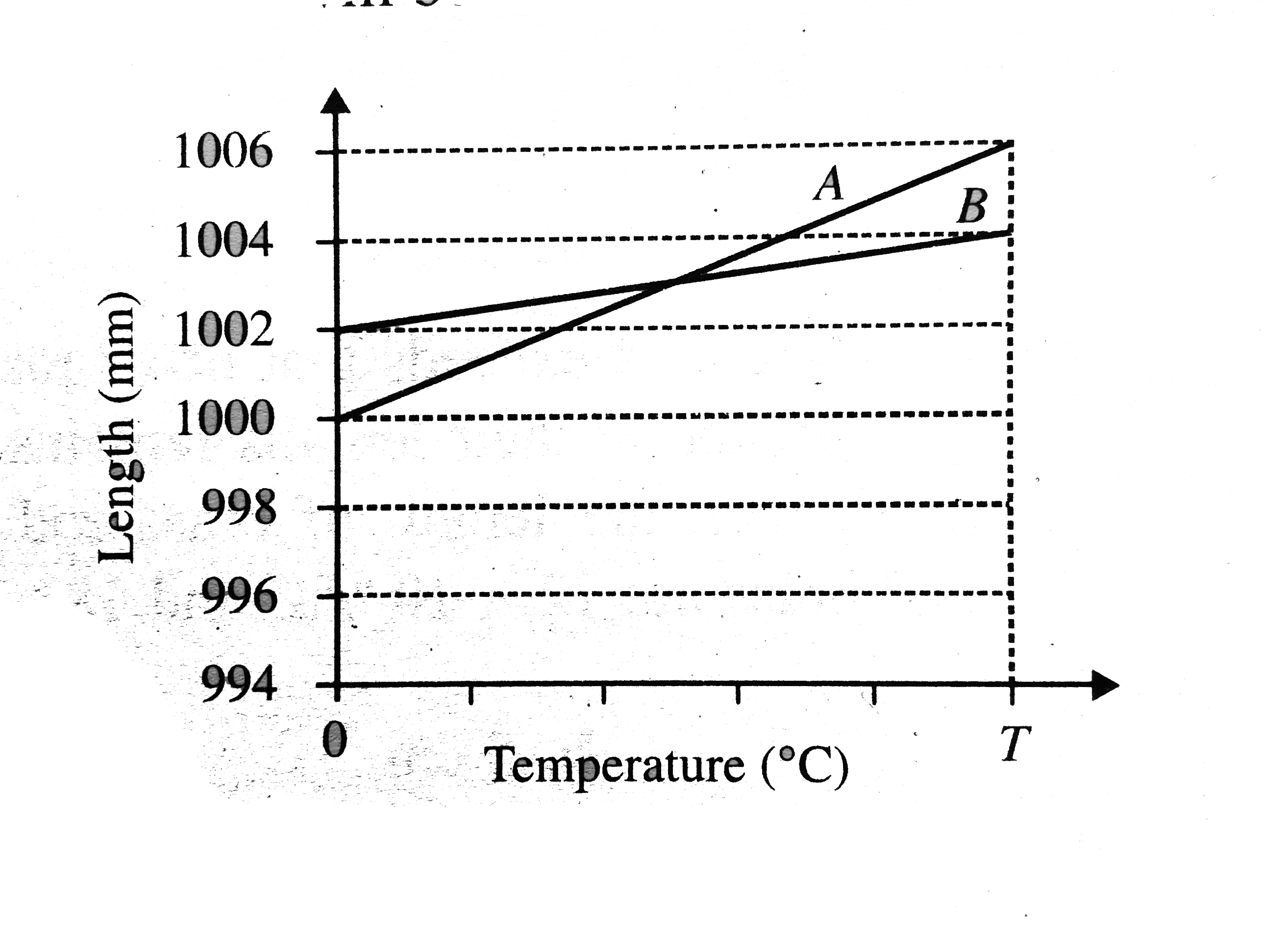A current carrying wire heats a metal rod. The wire provides a constant power P to the rod. The metal rod is enclosed in an insulated container. It is observed that the temperature (T) in the metal rod change with the (t) as T(t)=T0(1+βt1/4) where β is a constant with appropriate dimension of temperature. the heat capacity of metal is :
4P(T(t)−T0)2β4T40
4P(T(t)−T0)4β4T50
4P(T(t)−T0)2β4T20
4P(T(t)−T0)β4T20
Step by step video & image solution for A current carrying wire heats a metal rod. The wire provides a constant power P to the rod. The metal rod is enclosed in an insulated container. It is observed that the temperature (T) in the metal rod change with the (t) as T(t)=T_(0)(1+betat^(1//4)) where beta is a constant with appropriate dimension of temperature. the heat capacity of metal is : by Physics experts to help you in doubts & scoring excellent marks in Class 12 exams.
Updated on:21/07/2023Topper's Solved these Questions
Similar Questions
A small circular loop of area A and resistance R is fixed on a horizontal xy -plane with the center of the loop always on the axis ˆn of a long solenoid . The solenoid has m turns per unit length and carries current I counterclockwise as shown in the figure . THe magnetic field due to the solenoid is in ˆn direction, List -I gives time dependences of ˆn in terms of a constant angular frequency ω , List - II gives the torques experienced by the circular loop at time t=π6ω Let α=A2μ20m2l2ω2R

which one of the following options is correct ?
View SolutionThe specific heat of a metal at low temperatures varies according to S = aT^3 , where a is a constant and T is absolute temperature. The heat energy needed to raise unit mass of the metal from temperature T = 1 K to T = 2K is
View Solution
The variation of length of two metal rods A and B with change in temperature is shown in Fig. the coefficient of linear expansion αA for the metal A and the temperature T will be
View SolutionA current carrying wire heats a metal rod. The wire provides a constant power P to the rod. The metal rod is enclosed in an insulated container. It is observed that the temperature (T) in the metal rod change with the (t) as T(t)=T0(1+βt1/4) where β is a constant with appropriate dimension of temperature. the heat capacity of metal is :
View SolutionA rod of length L with sides fully insulated is made of a material whose thermal conductivity K varies with temperature as K=αT where α is constant. The ends of rod are at temperature T1 and T2(T2>T1) Find the rate of heat flow per unit area of rod .
View SolutionA thermally insulated piece of metal is heated under atmosphere by an electric current so that it receives electric energy at a constant power P. This leads to an increase of the absoulute temperature T of the metal with time t as follows T=a^(1/4) . then the heat capacity C_(p) is
View SolutionA rod of length l and cross-section area A has a variable thermal conductivity given by K = alpha T, where alpha is a positive constant and T is temperature in kelvin. Two ends of the rod are maintained at temperature T_(1) and T_(2) (T_(1)gtT_(2)) . Heat current flowing through the rod will be
View SolutionA meter scale calibarated for temperature T is used to measure the length of a steel rod. Length of steel rod measured by metal scale at temperature 2T is L. Length of the rod measured by metal scale at temperature T is [αs:Coefficient of linear expansion of metal scale, αR : Coefficient of linear expansion of steel rod]
View Solutionलम्बाई L तथा अनुप्रस्थ - क्षेत्रफल A वाली छड़ का एक सिरा T1 तापमान वाली भट्टी में रखा है | छड़ का दूसरा सिरा ताप T2 पर है | छड़ के पदार्थ की ऊष्मा चालकता K तथा उत्सर्जकताe है | दिया है : T2=Ts+ΔT, जहाँ ΔT<<Ts,Ts वातावरण का तापमान है | यदि ΔT∝(T1−Ts), तो अनुक्रमानुपाती नियतांक का मान ज्ञात कीजिए | मान कीजिए कि ऊष्मा का क्षय, केवल T2 ताप वाले सिरे से विकिरण के रूप में हो रहा है |

View Solutionएक धारा वाहक तार एक धातु की छड को गरम करता है| तार छड को एक स्थिर शक्ति P (constant power) प्रदान करता है| यह धातु छड एक अचालक बर्तन मे रखी गई है| यह पाया गया कि धातु का तापमान T, समय t के साथ निम्न प्रकार से परवर्तित होता है
T(t)=T0(1+βt14)
जहां, β एक उपयुक्त विमा का स्थिरांक है, जबकि T0 एक स्थिरांक है, जिसकी विमा वही है, जो ताप की है| धातु की ऊष्माधारिता है-
View Solutionएक धातु की छड़ ,जिसकी लम्बाई 'L' अनुप्रस्थ काट का क्षेत्रफल 'A' यंग प्रत्यास्थता गुणांक 'Y' तथा रेखीये प्रसार गुणांक 'α'है। , को 't'∘C तक गर्म किया जाता है । गर्मं करने पर धातु द्वारा किया गया कार्य हो सकता है
View Solutionहमारे शरीर के ताप से उच्चतम समान ताप की धातु की छड़ लकड़ी की छड़ की अपेक्षा अधिक तप्त प्रतीत होती है ? इसी प्रकार यदि ये दोनों हमारे शरीर के ताप से कम ताप पर है तो धातु की छड़ लकड़ी की छड़ की अपेक्षा शीतल प्रतीत होती है।
View SolutionThe specific heat of a metal at low temperatures varies according to S=aT3, where a is a constant and T is absolute temperature. The heat energy needed to raise unit mass of the metal from temperature T=1K to T=2K is
View Solutionएक छड जिसकी लम्बाई l और अनुप्रस्थ काट क्षेत्रफल A है की परिवर्ती ऊष्माचालकता k=αT, से दी जाती है, जहाँ α एक धनात्मक नियतांक है और T केल्विन में तापमान है छड़ के दोनों किनारे ताप T1 और T2(T1>T2) पर बने रहते हैं। छड़ से प्रवाहित ऊष्मीय धारा होगी-
View Solutionधातु के एक ऊष्मीय कुचालक टुकड़े को वायुमंडलीय दाब पर एक विद्युत धारा द्वारा इस प्रकार गर्म किया जाता है कि यह नियत शक्ति P पर विद्युत ऊर्जा प्राप्त करता रहे। इससे धातु के निरपेक्ष तापमान T में समय t के साथ
T(t)=T0[1+a(t−t0)]1/4 के रूप में वृद्धि होती है, जहां a,t0 और T0 नियतांक हैं। धातु की ऊष्मीय धारिता CP (T) है :
View Solution
The variation of length of two metal rods A and B with change in temperature is shown in Fig. the coefficient of linear expansion αA for the metal A and the temperature T will be
View Solution
